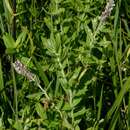en
names in breadcrumbs


Mountainous Southern Sinai.
Canary Islands, Europe, Mediterranean region, southwest Asia, tropical east and south Africa.
Canal banks, ditches and pools.
Perennial.
Mentha asiatica, M. vagans, and the Himalayan M. royleana Bentham all are very closely related to and perhaps doubtfully distinct from M. longifolia. Further work is needed to fully assess their correct status.
Mentha longifolia (also known as horse mint,[1] fillymint or St. John's horsemint; syn. M. spicata var. longifolia L., M. sylvestris L., M. tomentosa D'Urv, M. incana Willd.) is a species in the genus Mentha (mint) native to Europe excluding Britain and Ireland,[2] western and central Asia (east to Nepal and the far west of China), and northern and southern (but not tropical) Africa.[3][4][5]
It is a very variable herbaceous perennial plant with a peppermint-scented aroma. Like many mints, it has a creeping rhizome, with erect to creeping stems 40–120 cm tall. The leaves are oblong-elliptical to lanceolate, 5–10 cm long and 1.5–3 cm broad, thinly to densely tomentose, green to greyish-green above and white below. The flowers are 3–5 mm long, lilac, purplish, or white, produced in dense clusters (verticillasters) on tall, branched, tapering spikes; flowering in mid to late summer. It spreads via rhizomes to form clonal colonies.[5][6][7]
There are seven subspecies:[3][4][7]
It has been widely confused with tomentose variant plants of Mentha spicata; it can be distinguished from these by the hairs being simple unbranched, in contrast to the branched hairs of M. spicata.[6]
Mentha longifolia hybridizes with other Mentha species. Hybrids include:
Unlike other commonly cultivated species and hybrids of mint, there are few horticultural cultivars of M. longifolia.[8] The only ones of note are:
Like almost all mints, Mentha longifolia can be invasive. Care needs to be taken when planting it in non-controlled areas.
Nicholas Culpeper's Complete Herbal (1653) states that "It is good for wind and colic in the stomach ... The juice, laid on warm, helps the King's evil or kernels in the throat ... The decoction or distilled water helps a stinking breath, proceeding from corruption of the teeth, and snuffed up the nose, purges the head. It helps the scurf or dandruff of the head used with vinegar."[9] In addition, Mentha longifolia, like other Mentha species, is known to have important medicinal properties.[10]
Mentha longifolia (also known as horse mint, fillymint or St. John's horsemint; syn. M. spicata var. longifolia L., M. sylvestris L., M. tomentosa D'Urv, M. incana Willd.) is a species in the genus Mentha (mint) native to Europe excluding Britain and Ireland, western and central Asia (east to Nepal and the far west of China), and northern and southern (but not tropical) Africa.